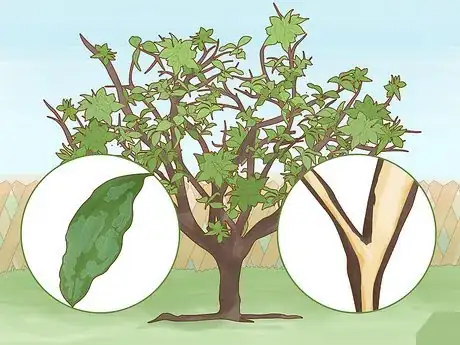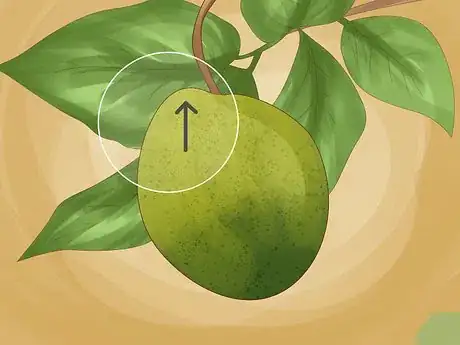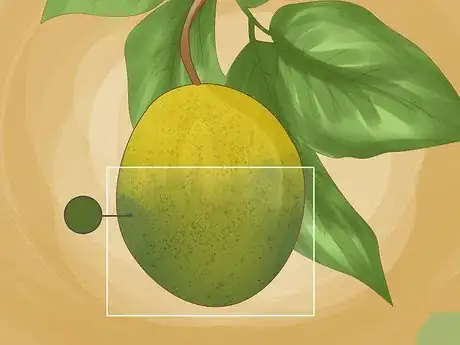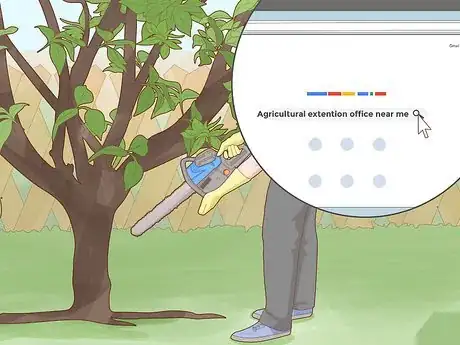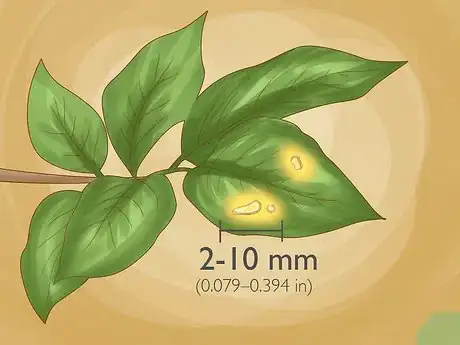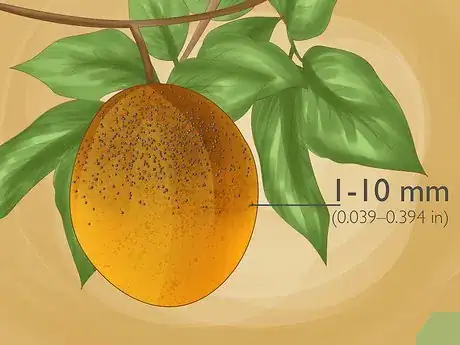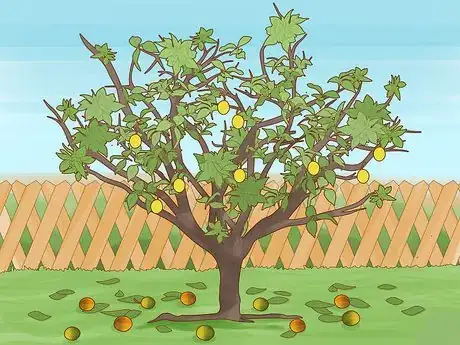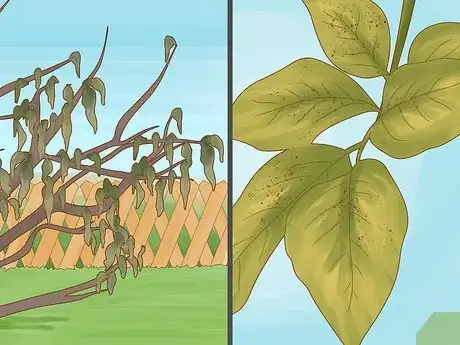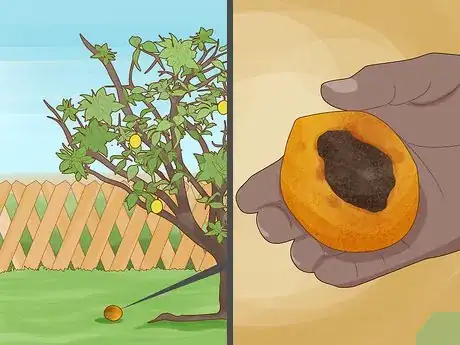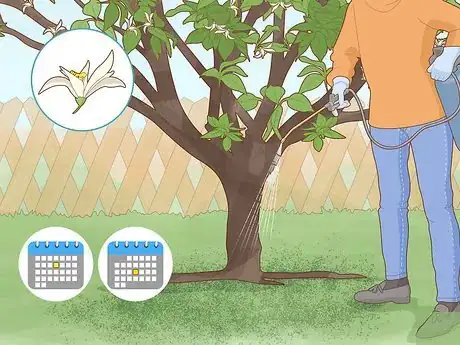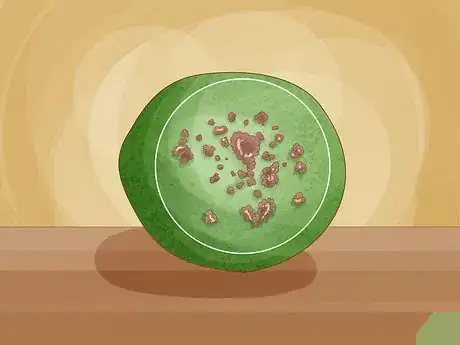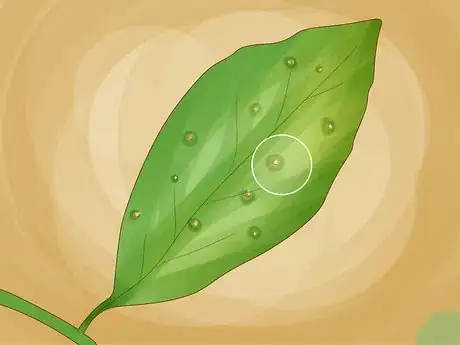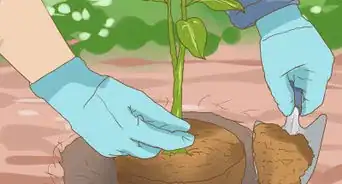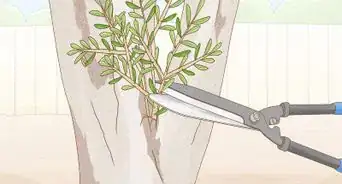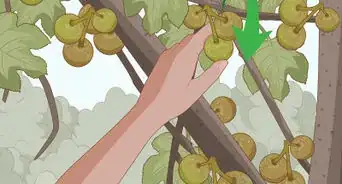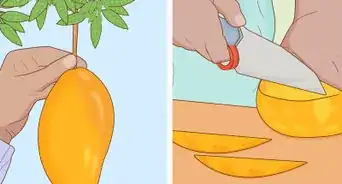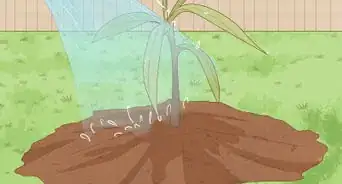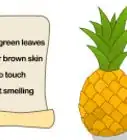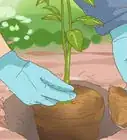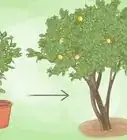This article was co-authored by Michael Simpson, PhD and by wikiHow staff writer, Megaera Lorenz, PhD. Dr. Michael Simpson (Mike) is a Registered Professional Biologist in British Columbia, Canada. He has over 20 years of experience in ecology research and professional practice in Britain and North America, with an emphasis on plants and biological diversity. Mike also specializes in science communication and providing education and technical support for ecology projects. Mike received a BSc with honors in Ecology and an MA in Society, Science, and Nature from The University of Lancaster in England as well as a Ph.D. from the University of Alberta. He has worked in British, North American, and South American ecosystems, and with First Nations communities, non-profits, government, academia, and industry.
There are 15 references cited in this article, which can be found at the bottom of the page.
This article has been viewed 22,898 times.
Lemon trees make a beautiful addition to any yard or grove. Unfortunately, they’re susceptible to a wide variety of diseases, including bacterial and fungal infections. If you’ve noticed that your lemons are looking spotty or dropping before they have a chance to get ripe, it’s possible they’ve picked up a disease. Four of the most common lemon diseases are citrus greening, citrus canker, black spot, and citrus scab. Get familiar with the symptoms of these diseases so you can figure out what’s afflicting your lemons and take appropriate action.
Steps
Citrus Greening
-
1Watch out for thinning leaves and dead branches. Citrus greening can cause the shoots and foliage of your lemon tree to die off, giving it a sparse and bedraggled look. Keep an eye out for trees that are missing a lot of leaves or have multiple branches that appear dead.[1]
- Your tree might also become stunted (meaning it doesn’t grow as much as it should) or bloom at the wrong time of the year (e.g., in summer or fall instead of spring).
Did you know? Citrus greening, also known as Huanglongbing, is a bacterial infection spread by an insect called the Asian citrus psyllid. The best way to prevent citrus greening is to protect your trees from psyllid infestation. Help prevent psyllid infestation by buying healthy plants from reputable nurseries, treating your trees with pesticides, and introducing beneficial insects into your grove or garden. Contact your local plant nursery or agricultural extension office for pest control advice.[2]
-
2Look for blotchy yellowing on the leaves.[3] One of the most distinctive characteristics of citrus greening is an asymmetrical, mottled yellowing of the leaves. In some cases, the veins of the leaves might also turn yellow or bulge out of the leaves (vein corking).[4]
- The yellowing of leaves with citrus greening can look similar to other conditions, such as root rot or a nutrient deficiency. However, the yellowing caused by citrus greening tends to look more random and less symmetrical than other types of yellowing.
Advertisement -
3Check for small, lopsided fruits. Lemons affected by citrus greening may look misshapen or smaller than usual.[5] They might be asymmetrical or unusually elongated.[6]
- If you cut the lemon open, you may notice that the central core is curved or misshapen or that the seeds look shriveled or discolored. The fruit might also have an unpleasant taste.
- Small or lopsided fruits can also be a sign of stubborn disease, a less common infection that is spread by leafhoppers.[7]
-
4Observe whether the fruits remain green at the blossom end.[8] Watch your lemons as they ripen. If they turn yellow at the stem end, but the rest of the fruit remains green, it’s possible that they have citrus greening.[9]
- Lemons can also remain partially green for other reasons, such as unusually warm weather in the spring.[10] If your lemons are still green but your tree seems otherwise healthy, then their color isn’t necessarily a cause for concern.
-
5Destroy infected trees according to your extension office’s instructions. Unfortunately, there’s no treatment for citrus greening. If you think your lemon tree might have this disease, contact your local agricultural extension office. They can examine the tree to confirm or rule out citrus greening and give you advice on how to safely dispose of your infected tree.[11]
- Do a search using terms like “agricultural extension office near me.”
Citrus Canker
-
1Check the leaves for lesions with concentric rings. Citrus canker infections start out as small, circular lesions on the undersides of the leaves, which quickly spread to the top surface as well. These lesions are typically raised at first, but will eventually develop a raised edge and sunken center, often with concentric rings around the center of the lesion. Look for lesions that are about 2–10 millimetres (0.079–0.394 in) across.[12]
- The borders of the lesions sometimes develop a yellow halo or have a waterlogged appearance.
- The lesions are typically brown, but they may develop a grey or white center as the disease progresses.
-
2Look for circular lesions on the fruit.[13] A lemon with citrus canker will develop brown, circular lesions on the rind. In some cases, these lesions will cluster together and become connected. They’ll typically have a raised center, like a pimple, and may also develop concentric rings around the middle. Check for lesions about 1–10 millimetres (0.039–0.394 in) across.[14]
- While the inside of the fruit isn’t usually affected by these lesions, some of them can cause the rind to crack and make it easier for other infections to move in.[15]
- You might also notice lesions on the stems.
-
3Make note of excessive fruit drop. Citrus canker normally only affects the appearance of the fruit, leaves, and stems, but in severe cases it can cause the lemons to start dropping off before they’re ripe.[16] If you notice fruit drop along with other characteristic symptoms, like the lesions on the leaves and fruit, this may be a sign of citrus canker.
- Severe infections are most common in very warm and wet conditions, e.g., if your lemon trees have been exposed to tropical storms.
-
4Watch for dead shoots and thinning leaves. A severe citrus canker infection can cause leaf drop, as well. You might notice that your lemon tree has bald patches, sparse leaves, or shoots that appear entirely dead.[17]
- Since there are many conditions that can cause these symptoms, don’t assume your tree has citrus canker based on sparse leaves alone. Look for the more characteristic lesions on the fruit and leaves as well.
-
5Ask your local extension office about how to destroy infected trees. If you think your lemon tree has citrus canker, it’s important to eliminate the tree so the infection doesn’t spread. Contact the closest agricultural extension office so they can examine your tree and help you determine what to do next.[18]
- The laws regarding the management of citrus canker vary from one place to another. Depending on where you live, you may be required to remove all citrus trees within a certain radius of the affected tree(s).
Tip: It’s easy to accidentally spread citrus canker between trees if you get the bacteria on your hands, clothes, or agricultural equipment. You can help protect your trees by sanitizing your clothes, skin, and equipment with antibacterial cleansers.[19]
Citrus Black Spot
-
1Look for dark brown or reddish spots or lesions on the fruit. Citrus black spot is a fungal infection that affects the fruit, leaves, and stems of citrus trees. The most recognizable symptom is the development of small spots or lesions on the rind of the fruit. These lesions can have a wide variety of appearances and may range in size from less than 1 millimetre (0.039 in) to 10 millimetres (0.39 in).[20] Look out for lesions on your lemons, which may look like:
- Brown or brick-red spots with grey or black centers. These lesions may have green halos around them.
- Lots of tiny, slightly raised bumps that are tan or dark brown, without grey or black centers. These are more likely to appear on lemons that are still green.
- Large, flat, dark-brown spots with raised cracks on them. These may eventually turn into the more typical lesions with grey or black centers as the fruit matures.
- Small, reddish, freckle-like spots that are irregular in shape. These most often appear on mature fruits.
Keep in mind: Black spot lesions tend to concentrate in areas where the fruit is most exposed to the sunlight. Check for trees that show the most symptoms on the side that gets the most sunlight during the day.[21]
-
2Check for fruit dropping before it’s ripe. If your lemon is severely infected, the fruit may begin to fall before it has a chance to mature. This is most likely to happen to lemons with “virulent spot” lesions, which are lesions that grow together and expand.[22]
- In addition to causing fruit drop, virulent spots can grow through the rind and affect the quality of the fruit itself.
-
3Watch for reddish-brown lesions on the leaves. Lemons are more likely than other types of citrus to develop lesions on the leaves. Look for lesions that begin as small, raised, reddish areas on the leaves. They will eventually develop a sunken grey center with a brown border. Some lesions may have a yellow halo around them.[23]
- You might also notice similar lesions on the stems and twigs.
-
4Manage black spot infections with anti-fungal treatments. Black spot infections are difficult to treat, but they don’t necessarily mean you have to destroy the affected trees. Treat your diseased trees with regular fungicidal applications (typically every 3-4 weeks) throughout the blooming season. Maximize the health of your trees and the rest of your crop by:[24]
- Cleaning up any leaf litter around the tree promptly
- Removing severely infected trees
- Irrigating your grove or orchard to keep your trees well-hydrated and prevent leaf drop
Citrus Scab
-
1Look for warty pink or brown scabs on the fruit. Citrus scab is a fungal infection that causes pustule-like lesions on the rinds of affected fruit. Your lemons may develop raised pinkish or brown spots that become more elevated and well-defined as they mature.[25]
- In the early stages, it’s easy to confuse these lesions with the ones caused by black spot. However, citrus scab lesions are typically lighter in color and more raised than black spot lesions.
-
2Check for raised bumps on leaves with a depression on the underside. In addition to lesions on the fruit, citrus scab causes distinctive lesions on the leaves. On the upper side of the leaf, these lesions may be elevated and scabby looking, typically with a yellowish-brown or grey color. They can cause deep, cone-shaped depressions to form on the underside of the leaf.[26]
- Leaves that are severely infested might appear deformed, twisted, or crumpled.[27]
- You might also notice scabby lesions on the twigs and stems.
-
3Treat your lemon tree with 3 fungicidal spray applications in the spring. Compared to many other lemon diseases, citrus scab is fairly easy to manage. Purchase a fungicidal spray, such as copper fungicide or Enable 2F, from a plant nursery or garden supply store. Apply the spray according to the package directions, following this schedule:[28]
- First application during the spring flush, or the period of rapid plant growth in early spring
- Second application during petal fall
- Third application 3 weeks after petal fall
Be aware: Citrus scab will make your lemons look unpleasant and might make them harder to sell, but it doesn’t actually affect the quality of the fruit. If you’re planning to process your lemons (e.g., turn them into juice or preserves), there’s no need to control this disease.[29]
Expert Q&A
-
QuestionWhat diseases do lemon trees get?
 Michael Simpson, PhDDr. Michael Simpson (Mike) is a Registered Professional Biologist in British Columbia, Canada. He has over 20 years of experience in ecology research and professional practice in Britain and North America, with an emphasis on plants and biological diversity. Mike also specializes in science communication and providing education and technical support for ecology projects. Mike received a BSc with honors in Ecology and an MA in Society, Science, and Nature from The University of Lancaster in England as well as a Ph.D. from the University of Alberta. He has worked in British, North American, and South American ecosystems, and with First Nations communities, non-profits, government, academia, and industry.
Michael Simpson, PhDDr. Michael Simpson (Mike) is a Registered Professional Biologist in British Columbia, Canada. He has over 20 years of experience in ecology research and professional practice in Britain and North America, with an emphasis on plants and biological diversity. Mike also specializes in science communication and providing education and technical support for ecology projects. Mike received a BSc with honors in Ecology and an MA in Society, Science, and Nature from The University of Lancaster in England as well as a Ph.D. from the University of Alberta. He has worked in British, North American, and South American ecosystems, and with First Nations communities, non-profits, government, academia, and industry.
Registered Professional Biologist Lemon trees are vulnerable to several diseases. Huanglongbing (citrus greening disease) and the oddly-named citrus stubborn disease are caused by bacteria and produce similar symptoms: blotchy yellow areas on the leaves and misshapen fruit.
Lemon trees are vulnerable to several diseases. Huanglongbing (citrus greening disease) and the oddly-named citrus stubborn disease are caused by bacteria and produce similar symptoms: blotchy yellow areas on the leaves and misshapen fruit. -
QuestionWhat is killing my lemon tree?
 Michael Simpson, PhDDr. Michael Simpson (Mike) is a Registered Professional Biologist in British Columbia, Canada. He has over 20 years of experience in ecology research and professional practice in Britain and North America, with an emphasis on plants and biological diversity. Mike also specializes in science communication and providing education and technical support for ecology projects. Mike received a BSc with honors in Ecology and an MA in Society, Science, and Nature from The University of Lancaster in England as well as a Ph.D. from the University of Alberta. He has worked in British, North American, and South American ecosystems, and with First Nations communities, non-profits, government, academia, and industry.
Michael Simpson, PhDDr. Michael Simpson (Mike) is a Registered Professional Biologist in British Columbia, Canada. He has over 20 years of experience in ecology research and professional practice in Britain and North America, with an emphasis on plants and biological diversity. Mike also specializes in science communication and providing education and technical support for ecology projects. Mike received a BSc with honors in Ecology and an MA in Society, Science, and Nature from The University of Lancaster in England as well as a Ph.D. from the University of Alberta. He has worked in British, North American, and South American ecosystems, and with First Nations communities, non-profits, government, academia, and industry.
Registered Professional Biologist Your tree may be infected by a viral disease. Possible diseases include tristeza, exocortis, and psorosis. Tristeza damages the stem, branches and leaves and can be fatal to lemon trees, while exocortis can lead to stunted growth but doesn’t typically kill the tree. If your tree is starting to lose its bark, has yellow spots on the leaves and has discoloured fruit, though, it might be suffering from psorosis.
Your tree may be infected by a viral disease. Possible diseases include tristeza, exocortis, and psorosis. Tristeza damages the stem, branches and leaves and can be fatal to lemon trees, while exocortis can lead to stunted growth but doesn’t typically kill the tree. If your tree is starting to lose its bark, has yellow spots on the leaves and has discoloured fruit, though, it might be suffering from psorosis.
References
- ↑ Michael Simpson, PhD. Registered Professional Biologist. Expert Interview. 8 September 2021.
- ↑ http://californiacitrusthreat.org/protect-your-citrus/
- ↑ Michael Simpson, PhD. Registered Professional Biologist. Expert Interview. 8 September 2021.
- ↑ https://crec.ifas.ufl.edu/extension/greening/symptoms.shtml
- ↑ Michael Simpson, PhD. Registered Professional Biologist. Expert Interview. 8 September 2021.
- ↑ http://gardeningsolutions.ifas.ufl.edu/care/pests-and-diseases/diseases/citrus-greening-faq.html
- ↑ http://ipm.ucanr.edu/PMG/r107101211.html
- ↑ Michael Simpson, PhD. Registered Professional Biologist. Expert Interview. 8 September 2021.
- ↑ http://gardeningsolutions.ifas.ufl.edu/care/pests-and-diseases/diseases/citrus-greening-faq.html
- ↑ Michael Simpson, PhD. Registered Professional Biologist. Expert Interview. 8 September 2021.
- ↑ https://extension.arizona.edu/sites/extension.arizona.edu/files/pubs/az1492.pdf
- ↑ https://idtools.org/id/citrus/diseases/factsheet.php?name=Citrus%20canker
- ↑ Michael Simpson, PhD. Registered Professional Biologist. Expert Interview. 8 September 2021.
- ↑ https://idtools.org/id/citrus/diseases/factsheet.php?name=Citrus%20canker
- ↑ https://www.apsnet.org/edcenter/disandpath/prokaryote/pdlessons/Pages/CitrusCanker.aspx
- ↑ https://www.apsnet.org/edcenter/disandpath/prokaryote/pdlessons/Pages/CitrusCanker.aspx
- ↑ https://www.apsnet.org/edcenter/disandpath/prokaryote/pdlessons/Pages/CitrusCanker.aspx
- ↑ https://www.apsnet.org/edcenter/disandpath/prokaryote/pdlessons/Pages/CitrusCanker.aspx
- ↑ https://www.apsnet.org/edcenter/disandpath/prokaryote/pdlessons/Pages/CitrusCanker.aspx
- ↑ https://idtools.org/id/citrus/diseases/factsheet.php?name=Citrus%20Black%20Spot
- ↑ https://crec.ifas.ufl.edu/extension/black_spot/PDF/Black%20spot%20management%20round%20table.pdf
- ↑ https://idtools.org/id/citrus/diseases/factsheet.php?name=Citrus%20Black%20Spot
- ↑ https://idtools.org/id/citrus/diseases/factsheet.php?name=Citrus%20Black%20Spot
- ↑ https://crec.ifas.ufl.edu/extension/black_spot/PDF/Black%20spot%20management%20round%20table.pdf
- ↑ https://idtools.org/id/citrus/diseases/factsheet.php?name=Citrus%20scab
- ↑ https://idtools.org/id/citrus/diseases/factsheet.php?name=Citrus%20scab
- ↑ https://crec.ifas.ufl.edu/extension/trade_journals/2012/2012_Mar_citrus_scab.pdf
- ↑ https://edis.ifas.ufl.edu/cg020
- ↑ https://www.ctahr.hawaii.edu/oc/freepubs/pdf/PD-60.pdf
- ↑ https://www.usda.gov/media/blog/2012/04/12/identify-citrus-diseases-new-iphone-app
